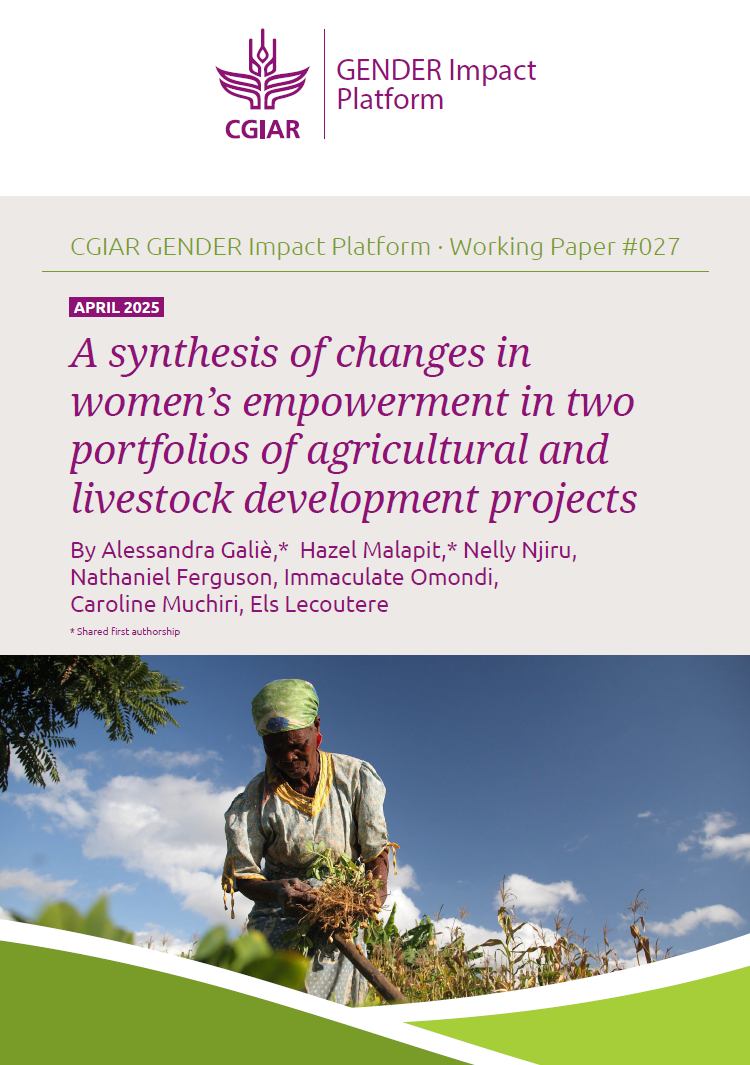A synthesis of changes in women’s empowerment in two portfolios of agricultural and livestock development projects: CGIAR GENDER Impact Platform Working Paper #27
Abstract
The intrinsic and instrumental value of gender equality and women’s empowerment is recognized by Sustainable Development Goal (SDG) 5. Evidence on positive changes to women’s empowerment in agriculture and livestock interventions is expanding but is still relatively limited. Portfolios of projects focused on women’s empowerment through agriculture and livestock interventions can provide key insights across approaches and contexts.
In this working paper, we synthesize evaluations of the effects of interventions with empowerment objectives from two portfolios of agricultural development projects: the Livestock Vaccine Innovation Fund and the Cultivate Africa’s Future projects. These projects were implemented in 10 African countries and one South Asian country between 2017 and 2023, and funded by Canada’s International Development Research Centre (together with others). The projects used the project-level Women’s Empowerment in Agriculture Index (pro-WEAI) and the Women’s Empowerment in Livestock Index (WELI) tools to measure empowerment. The main objective of this study is to examine whether the agriculture- and livestock-related development projects impacted women’s empowerment at the portfolio level, to draw conclusions for the design and implementation of future project portfolios that aim to enhance gender equality and women’s empowerment.
We use both quantitative and qualitative data reported by the projects in the two portfolios. The quantitative analysis synthesizes impact estimates on WELI and pro-WEAI aggregate indices from projects using quasi-experimental or experimental designs, as well as percentage changes in these indices between baseline and endline assessments. The qualitative analysis examines patterns of commonalities or differences in how empowerment is conceptualized, how it evolves over the course of the projects, and how project participants perceive changes in their lived empowerment experience.
The quantitative results show mostly null findings, consistent with the emerging empowerment literature that suggests moving the needle on women’s empowerment requires intentional programming and appropriate levels of investment. We find the most promising results are from projects with explicit strategies to influence and transform gender norms.
The qualitative findings highlight the importance of capturing local conceptualizations of empowerment to contextualize empowerment and its quantitative assessments. The results show that resource ownership is a key indicator of empowerment for both women and men. Women, however, most value the ability to manage their finances independently while men most value being able to support other family members. Both women and men see the value of groups for their empowerment. Finally, women’s empowerment is tied to men’s support.
The results provide much needed information on the most effective approaches to support women’s empowerment, indicating that intentional and transformative approaches are most beneficial. Methodologically, the working paper shows (1) the importance of portfolio projects with shared goals and consistent measurement tools for women’s empowerment, (2) the complexity of combining the goals of research and those of development partners, (3) the value of using both quantitative and qualitative methods, and (4) the need for dedicated financial resources to support systematic impact assessments, meta-analysis and synthesis work.

